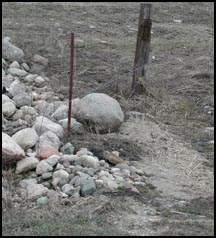 Terry Schaefer's farm lies on the border of Kandiyohi and Stearns counties, maybe three miles as a crow flies from the North Fork of the Crow River and dozens of miles from the Mississippi. Yet it's here, between two pasture hills, that efforts have been taken to reduce the flow of water in those rivers, and consequently the floodings during wet springs like 2001.
Terry Schaefer's farm lies on the border of Kandiyohi and Stearns counties, maybe three miles as a crow flies from the North Fork of the Crow River and dozens of miles from the Mississippi. Yet it's here, between two pasture hills, that efforts have been taken to reduce the flow of water in those rivers, and consequently the floodings during wet springs like 2001.Three years ago, Schaefer received grant money to install a berm through his rolling pasture that follows a meandering crick. He created a seven-acre, 14-foot-deep pond to hold water temporarily. The crick drains water from a 800- or 900-acre watershed and eventually flows into the Crow River between Paynesville and Regal. Then the water flows through Paynesville, north to Rice Lake, down to Koronis, and on through the Crow to the Mississippi River.
The line of sediment left after the recent flood is still visible on the sides of Schaefer's sediment basin.
In the three years since the 290-feet long, 65-feet wide berm was built, it hasn't ever been fully tested. The closest was a two-and-a-half-inch rain in the spring of 1999, but since then the weather has been so dry that the pond only held a little water below an 18-inch drain pipe that stands three feet off the floor of the sediment basin.
This spring, however, the berm was tested and passed with flying colors. "I was really impressed that it worked like designed," said Schaefer..
Schaefer serves as a supervisor in Roseville Township, and through that on the board for the Kandiyohi County Soil and Water Conser-vation District (SWCD). Becoming more familiar with this program got him to try this first project..
Since he lives in Kandiyohi County, but the water his pond holds comes from Stearns County to the north, the project was done jointly with the Stearns County SWCD..
Schaefer's main concern in doing the project was he didn't want the water in the sediment basin to be backed up onto his crop land. He wanted to confine the created pond to his pasture land. Using that as a focal point in design, the berm between two hills was made at a level to allow water to run off before it reaches the surrounding fields..
Normally, water only flows from the 18-inch pipe and then on through the small crick, but a run-off area to one side allows water to flow through and not over the top of the berm..
After the rain and melt in early April, Schaefer checked the pond at night and found it just above its normal level, then came back the next morning and found the water a couple feet from the top. Just as designed, about eight inches of water was flowing through the overflow channel. .
That overflow channel has a protective fabric underneath to prevent erosion, anchored by thousands of rocks..
After the water flowed through the basin in a few days, it left debris and sediment littering the walls of the earthen damn. .
Schaefer has farmed 290 acres, of which 215 is tilled, for the past 15 years. He milks 30 dairy cows and keeps 65 cows on the farm that has been in his family since 1946. .
He also experimented with a natural snow fence this winter. He left four rows of corn standing along County Road 142 and was amazed by how much snow it kept from the road, which was blocked for six days in the winter of 1996-97. His neighbor has planted trees as a living snow fence on another part of the road, which is exposed to northwesterly winds..
He is so pleased with his first earthen basin that he is working with the SWCDs from Kandiyohi and Stearns on another berm project. Between two other hills in his pasture, another temporary crick drains water from farm land above it. This berm will be smaller, but deeper, than the original one..
These county agencies are also hoping to do other erosion control and bank stabilization projects on the Crow River between Paynesville and Regal..
Schaefer says that government agencies are looking for worthwhile projects and the available financing makes it affordable for farmers. His original project cost $24,000, of which 75 percent came from the Environmental Quality Incentive Program. Schaefer was helped by the Koronis Lake Association, the North Fork Crow River Watershed District, and the Kandiyohi County Water Plan to cover the local 25 percent share of the project..
"What we're finding out now," he said, "is that there are enough local organizations with money to fund these projects."